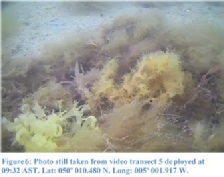Geophysical: Biological
Falmouth, 2014
This page includes
The Fal estuary is a very notable example of a prehistoric drowned valley system (or ria).
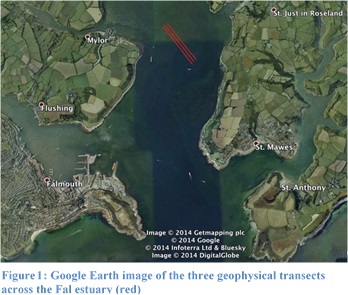
Carrick Roads is a deep channel running through the middle of the estuary, which is made up of sublittoral mud with bare rock outcrops and is roughly at 30m water depth.
Where as the shallower banks either side of Carrick roads are roughly 10m consist of sublittoral muddy gravel.
This range of substrate and tidal amplitude results in an abundance in biodiversity. Such as the extensive zones of living and dead mearl gravel at the lower Fal on St Mawes Bank (Fal and Helford, JNCC) which is the only example of a living mearl bed in Southern Britain (Perrins et al., 1995). Also Zostera marina (eelgrass) beds just off St Mawes provide an ideal breeding ground for juvenile fish and larvae, as such are hotspots for marine biodiversity. Because of this the Fal estuary has been assigned a special area of conservation (SAC). As such the local habitats and environment are under protection. Five video transects where also undertaken to provide ground truthing and to support the findings made with the sidescan sonar data, as a Van Veen Grab was prohibited in the SAC zone.
The majority of the video transects showed extensive coverage of seaweed with 8/8 coverage, most abundant is Hinanthalia elongate (Thongweed), Ectocarpus silisclosus (Maiden Hair) and Ahnfeltia plicata (Landlady’s Wig). In video 1 several other macroalgae species were present such as Japweed and Kelp
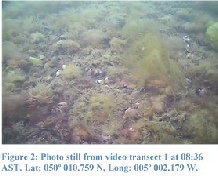
Video 2 however showed a lower coverage of seaweed roughly with 3/8 and some areas of exposed gravel sediment. Dead maerl fragments as well as a large Crepidula fornicata (Slipper limpet) where also observed, along with an Asterias rubens (Common starfish) as shown in figure 3. The common starfish is likely to be an active hunter a prey on small molluscs found throughout the study area.
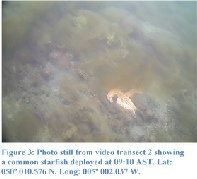
From video 3 we can see extensive coverage of seaweed with 6/8, as well as a Macropodia tenuirostris and Carcinus maenas (spider and common shore crab). These crustaceans are likely to be scavengers of detrital matter that settles from the sea surface.
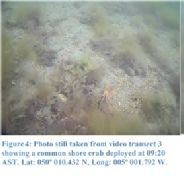
Video transect 4 unusually shows large areas of exposed sediment, mainly consisting of muddy gravel with very scarce patches of macroalgae. This could have arisen as the Fal estuary is a very busy harbour for both commercial and leisure activities, as well anchorage for larger vessels. The large volume of ships that pass through Falmouth harbour could disturb and destroy the delicate benthic habitats. Such as scallop dredgers that were banned by DEFRA in 2008 that worked further offshore(Solandt, 2009). The majority of the substrate was made up of broken shell fragments dead biological debris.
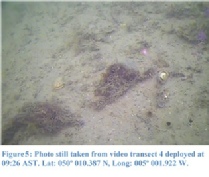
Video transect 5 showed extensive seaweed coverage, roughly 7/8. Several different macro algae species were observed with the most abundant being Hinanthalia elongate (Thongweed). Other organisms of interest were sea sponges, Corallina Officinalis (Coral Weed), Ectocarpus siliculosus (Maiden’s Hair).
